上一节已经添加了eureka服务发现和服务治理中心,里面只有它自己显然是没有啥用的,这时候我们自己写好的业务微服务如何注册到注册中心呢?
做微服务架构首先是微服务的划分,这次的例子主要以用户购买商品并下单的方式来划分微服务,总共划分三个微服务:
- cloud-user 用户微服务(用来维护用户基本信息)
- cloud-order 订单微服务 (用来维护订单基本信息)
- cloud-good 商品微服务 (用来维护商品基本信息)
不仅划分服务还划分数据库,每个微服务对应一个数据库这也是最大化的解耦,这种方式比如写了一个角色权限的微服务,其实用户角色权限大部分系统都差不多,有其他项目要用,只需要将一个微服务jar包和此微服务对应的数据库拿过去就可以了,这样就可以很方便的完成项目重复功能的复用
项目大体功能就是用户购买商品然后下单,会有服务调用操作,异步操作,消息提醒,数据聚合,网关路由,权限限制等。
其他两个微服务的注册后面会讲解,这节主要讲解用户微服务的编写和注册
目录
1、创建数据库表结构
create schema if not exists cloud_user collate utf8mb4_0900_ai_ci; create table if not exists user ( id char(32) not null, user_name varchar(20) not null comment '用户名', nick_name varchar(20) not null comment '用户昵称', user_pswd varchar(50) not null comment '用户密码', create_date datetime not null comment '创建日期', create_by char(32) not null comment '创建人', update_date datetime not null comment '更新日期', update_by char(32) not null comment '更新人', constraint user_id_uindex unique (id) ) comment '用户表'; alter table user add primary key (id);
2、新建cloud-user微服务子模块
新建方式和上一节是类似的,这里就不再说了
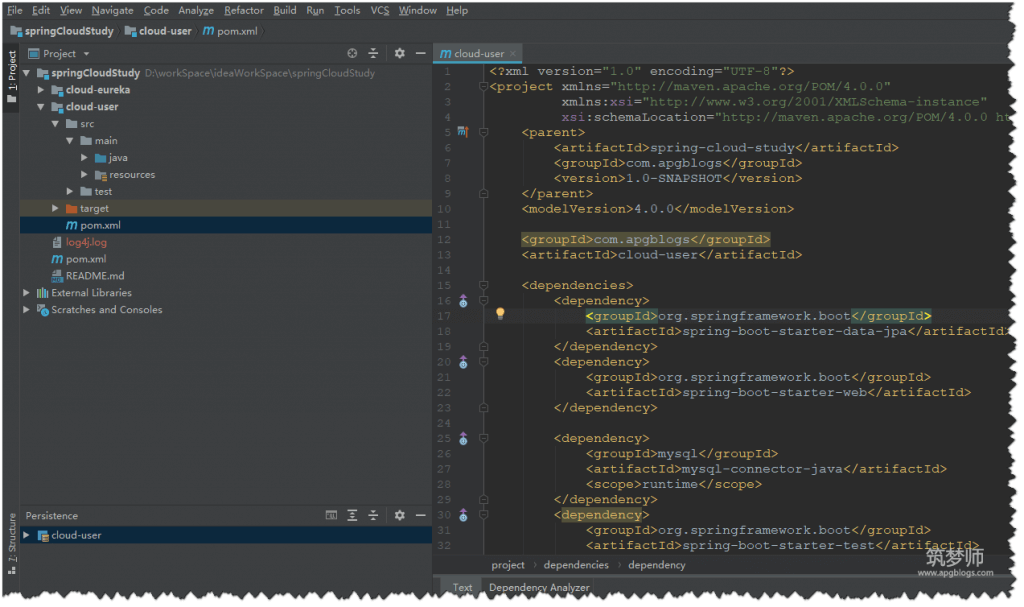
3、添加用户微服务需要的依赖
在用户微服务pom.xml中添加如下代码
这里集成了druid数据库连接池,mysql jdbc驱动,jpa以及服务注册需要的依赖
<?xml version="1.0" encoding="UTF-8"?>
<project xmlns="http://maven.apache.org/POM/4.0.0"
xmlns:xsi="http://www.w3.org/2001/XMLSchema-instance"
xsi:schemaLocation="http://maven.apache.org/POM/4.0.0 http://maven.apache.org/xsd/maven-4.0.0.xsd">
<parent>
<artifactId>spring-cloud-study</artifactId>
<groupId>com.apgblogs</groupId>
<version>1.0-SNAPSHOT</version>
</parent>
<modelVersion>4.0.0</modelVersion>
<groupId>com.apgblogs</groupId>
<artifactId>cloud-user</artifactId>
<dependencies>
<dependency>
<groupId>org.springframework.boot</groupId>
<artifactId>spring-boot-starter-data-jpa</artifactId>
</dependency>
<dependency>
<groupId>org.springframework.boot</groupId>
<artifactId>spring-boot-starter-web</artifactId>
</dependency>
<dependency>
<groupId>mysql</groupId>
<artifactId>mysql-connector-java</artifactId>
<scope>runtime</scope>
</dependency>
<dependency>
<groupId>org.springframework.boot</groupId>
<artifactId>spring-boot-starter-test</artifactId>
<scope>test</scope>
</dependency>
<!-- 数据库连接池 -->
<dependency>
<groupId>com.alibaba</groupId>
<artifactId>druid-spring-boot-starter</artifactId>
<version>1.1.10</version>
</dependency>
<dependency>
<groupId>log4j</groupId>
<artifactId>log4j</artifactId>
<version>1.2.17</version>
</dependency>
<dependency>
<groupId>com.google.code.gson</groupId>
<artifactId>gson</artifactId>
<version>2.8.5</version>
</dependency>
<!--服务客户端 -->
<dependency>
<groupId>org.springframework.cloud</groupId>
<artifactId>spring-cloud-starter-netflix-eureka-client</artifactId>
</dependency>
</dependencies>
</project>
4、创建controller,entity,service,repository等包
创建如下图所示的包和对应的类,entity中的实体类可以采用表映射的方式自动生成,对于如何表映射生成实体类可以访问下面的这篇文章链接
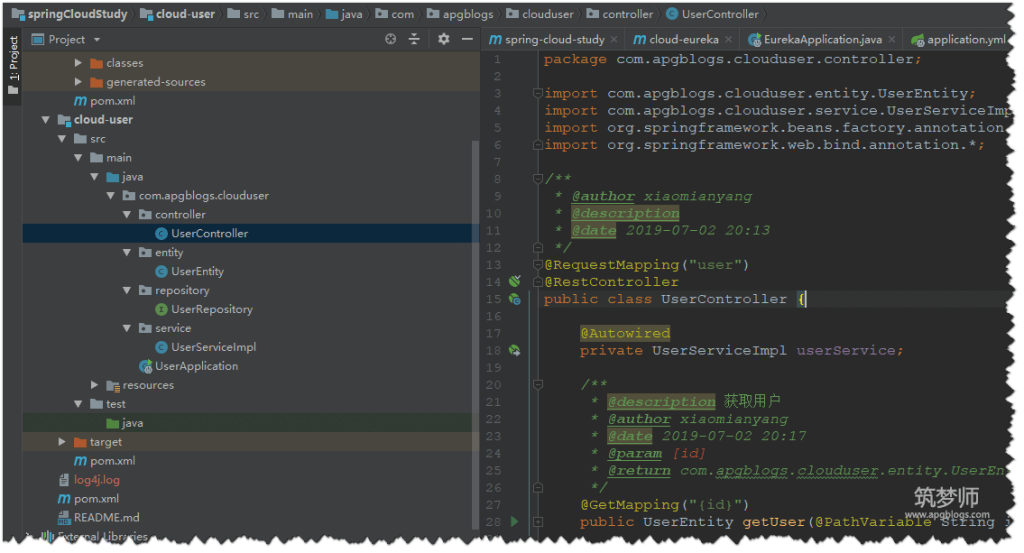
UserEntity类
package com.apgblogs.clouduser.entity;
import org.hibernate.annotations.GenericGenerator;
import org.springframework.data.annotation.CreatedDate;
import org.springframework.data.annotation.LastModifiedDate;
import org.springframework.data.jpa.domain.support.AuditingEntityListener;
import javax.persistence.*;
import java.sql.Timestamp;
import java.util.Objects;
/**
* @author xiaomianyang
* @description
* @date 2019-07-02 20:10
*/
@Entity
@EntityListeners(AuditingEntityListener.class)
@Table(name = "user", schema = "cloud_user", catalog = "")
public class UserEntity {
private String id;
private String userName;
private String nickName;
private String userPswd;
private Timestamp createDate;
private String createBy;
private Timestamp updateDate;
private String updateBy;
@Id
@Column(name = "id", nullable = false, length = 32)
@GenericGenerator(name = "jpa-uuid", strategy = "uuid")
@GeneratedValue(generator = "jpa-uuid")
public String getId() {
return id;
}
public void setId(String id) {
this.id = id;
}
@Basic
@Column(name = "user_name", nullable = false, length = 20)
public String getUserName() {
return userName;
}
public void setUserName(String userName) {
this.userName = userName;
}
@Basic
@Column(name = "nick_name", nullable = false, length = 20)
public String getNickName() {
return nickName;
}
public void setNickName(String nickName) {
this.nickName = nickName;
}
@Basic
@Column(name = "user_pswd", nullable = false, length = 50)
public String getUserPswd() {
return userPswd;
}
public void setUserPswd(String userPswd) {
this.userPswd = userPswd;
}
@Basic
@Column(name = "create_date", nullable = false)
@CreatedDate
public Timestamp getCreateDate() {
return createDate;
}
public void setCreateDate(Timestamp createDate) {
this.createDate = createDate;
}
@Basic
@Column(name = "create_by", nullable = false, length = 32)
public String getCreateBy() {
return createBy;
}
public void setCreateBy(String createBy) {
this.createBy = createBy;
}
@Basic
@Column(name = "update_date", nullable = false)
@LastModifiedDate
public Timestamp getUpdateDate() {
return updateDate;
}
public void setUpdateDate(Timestamp updateDate) {
this.updateDate = updateDate;
}
@Basic
@Column(name = "update_by", nullable = false, length = 32)
public String getUpdateBy() {
return updateBy;
}
public void setUpdateBy(String updateBy) {
this.updateBy = updateBy;
}
@Override
public boolean equals(Object o) {
if (this == o) return true;
if (o == null || getClass() != o.getClass()) return false;
UserEntity that = (UserEntity) o;
return Objects.equals(id, that.id) &&
Objects.equals(userName, that.userName) &&
Objects.equals(nickName, that.nickName) &&
Objects.equals(userPswd, that.userPswd) &&
Objects.equals(createDate, that.createDate) &&
Objects.equals(createBy, that.createBy) &&
Objects.equals(updateDate, that.updateDate) &&
Objects.equals(updateBy, that.updateBy);
}
@Override
public int hashCode() {
return Objects.hash(id, userName, nickName, userPswd, createDate, createBy, updateDate, updateBy);
}
}
UserRepository接口
package com.apgblogs.clouduser.repository;
import com.apgblogs.clouduser.entity.UserEntity;
import org.springframework.data.jpa.repository.JpaRepository;
/**
* @author xiaomianyang
* @description
* @date 2019-07-02 20:12
*/
public interface UserRepository extends JpaRepository<UserEntity,String> {
}
UserServiceImpl 用户业务实现类
package com.apgblogs.clouduser.service;
import com.apgblogs.clouduser.entity.UserEntity;
import com.apgblogs.clouduser.repository.UserRepository;
import org.springframework.beans.factory.annotation.Autowired;
import org.springframework.stereotype.Service;
import org.springframework.util.StringUtils;
/**
* @author xiaomianyang
* @description
* @date 2019-07-02 20:15
*/
@Service
public class UserServiceImpl {
@Autowired
private UserRepository userRepository;
/**
* @description 通过用户Id获取用户
* @author xiaomianyang
* @date 2019-07-02 20:16
* @param [id]
* @return com.apgblogs.clouduser.entity.UserEntity
*/
public UserEntity getUser(String id){
if(!userRepository.existsById(id)){
return null;
}
return userRepository.findById(id).get();
}
/**
* @description 保存用户
* @author xiaomianyang
* @date 2019-07-02 20:19
* @param [userEntity]
* @return com.apgblogs.clouduser.entity.UserEntity
*/
public UserEntity saveUser(UserEntity userEntity){
if(StringUtils.isEmpty(userEntity)){
return null;
}
userEntity.setCreateBy("sys");
userEntity.setUpdateBy("sys");
return userRepository.save(userEntity);
}
}
UserController 用户控制器
package com.apgblogs.clouduser.service;
import com.apgblogs.clouduser.entity.UserEntity;
import com.apgblogs.clouduser.repository.UserRepository;
import org.springframework.beans.factory.annotation.Autowired;
import org.springframework.stereotype.Service;
import org.springframework.util.StringUtils;
/**
* @author xiaomianyang
* @description
* @date 2019-07-02 20:15
*/
@Service
public class UserServiceImpl {
@Autowired
private UserRepository userRepository;
/**
* @description 通过用户Id获取用户
* @author xiaomianyang
* @date 2019-07-02 20:16
* @param [id]
* @return com.apgblogs.clouduser.entity.UserEntity
*/
public UserEntity getUser(String id){
if(!userRepository.existsById(id)){
return null;
}
return userRepository.findById(id).get();
}
/**
* @description 保存用户
* @author xiaomianyang
* @date 2019-07-02 20:19
* @param [userEntity]
* @return com.apgblogs.clouduser.entity.UserEntity
*/
public UserEntity saveUser(UserEntity userEntity){
if(StringUtils.isEmpty(userEntity)){
return null;
}
userEntity.setCreateBy("sys");
userEntity.setUpdateBy("sys");
return userRepository.save(userEntity);
}
}
5、编写启动类,添加服务发现和启用jpa注解
UserApplication 启动类
@EnableJpaAuditing 主要是用来自动生成实体类创建日期和修改日期的
@EnableDiscoveryClient 表示该类是一个服务客户端,可以被服务注册中心所发现
package com.apgblogs.clouduser;
import org.springframework.boot.SpringApplication;
import org.springframework.boot.autoconfigure.SpringBootApplication;
import org.springframework.cloud.client.discovery.EnableDiscoveryClient;
import org.springframework.data.jpa.repository.config.EnableJpaAuditing;
/**
* @author xiaomianyang
* @description
* @date 2019-07-02 20:07
*/
@SpringBootApplication
@EnableJpaAuditing
@EnableDiscoveryClient
public class UserApplication {
public static void main(String[] args) {
SpringApplication.run(UserApplication.class,args);
}
}
6、编写配置文件
创建两个配置文件,如下图
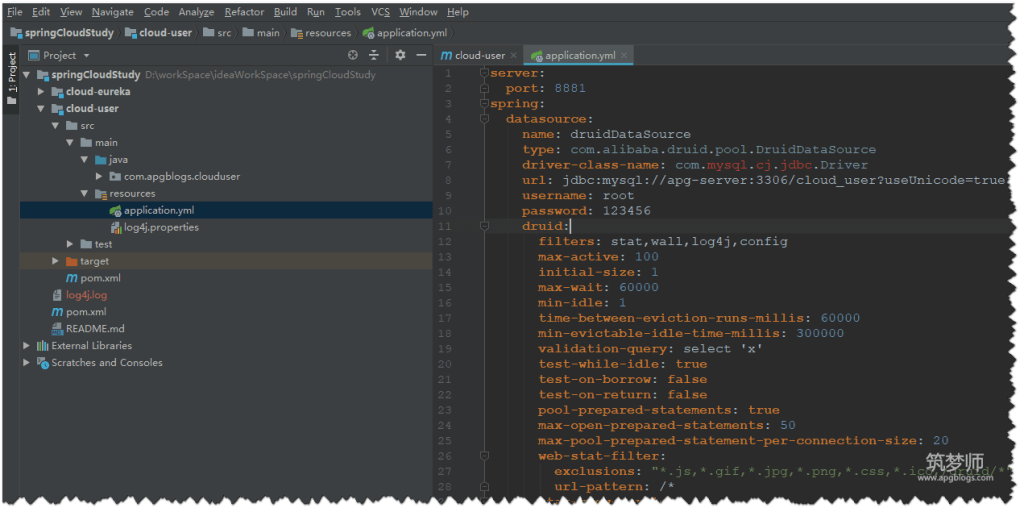
application.yml
以下配置文件主要是连接数据库和jpa的配置,这些之前springBoot都有介绍,eureka就是服务注册中心地址的配置,配置了这个注解在配合启动类上的@EnableDiscoveryClient注解就可以完成服务的注册了
server:
port: 8881
spring:
datasource:
name: druidDataSource
type: com.alibaba.druid.pool.DruidDataSource
driver-class-name: com.mysql.cj.jdbc.Driver
url: jdbc:mysql://apg-server:3306/cloud_user?useUnicode=true&characterEncoding=UTF-8&autoReconnect=true&failOverReadOnly=false&serverTimezone=Asia/Shanghai
username: root
password: 123456
druid:
filters: stat,wall,log4j,config
max-active: 100
initial-size: 1
max-wait: 60000
min-idle: 1
time-between-eviction-runs-millis: 60000
min-evictable-idle-time-millis: 300000
validation-query: select 'x'
test-while-idle: true
test-on-borrow: false
test-on-return: false
pool-prepared-statements: true
max-open-prepared-statements: 50
max-pool-prepared-statement-per-connection-size: 20
web-stat-filter:
exclusions: "*.js,*.gif,*.jpg,*.png,*.css,*.ico,/druid/*"
url-pattern: /*
stat-view-servlet:
allow: 127.0.0.1
deny: apg-server
login-username: admin
login-password: admin
reset-enable: true
jpa:
database-platform: org.hibernate.dialect.MySQL5InnoDBDialect
show-sql: true
hibernate:
ddl-auto: none
application:
name: cloud-user
#服务注册地址配置
eureka:
client:
service-url:
defaultZone: http://localhost:8801/eureka/
instance:
prefer-ip-address: true
log4j.properties log属性文件
log4j.rootLogger=debug, stdout, R log4j.appender.stdout=org.apache.log4j.ConsoleAppender log4j.appender.stdout.layout=org.apache.log4j.PatternLayout log4j.appender.stdout.layout.ConversionPattern=%5p - %m%n log4j.appender.R=org.apache.log4j.RollingFileAppender log4j.appender.R.File=log4j.log log4j.appender.R.MaxFileSize=100KB log4j.appender.R.MaxBackupIndex=1 log4j.appender.R.layout=org.apache.log4j.PatternLayout log4j.appender.R.layout.ConversionPattern=%p %t %c - %m%n
7、注释掉之前Eureka的高可用将配置2注释掉,目前还用不到所以也没必要启动那么多服务
在eureka微服务中对配置文件以下代码进行注册
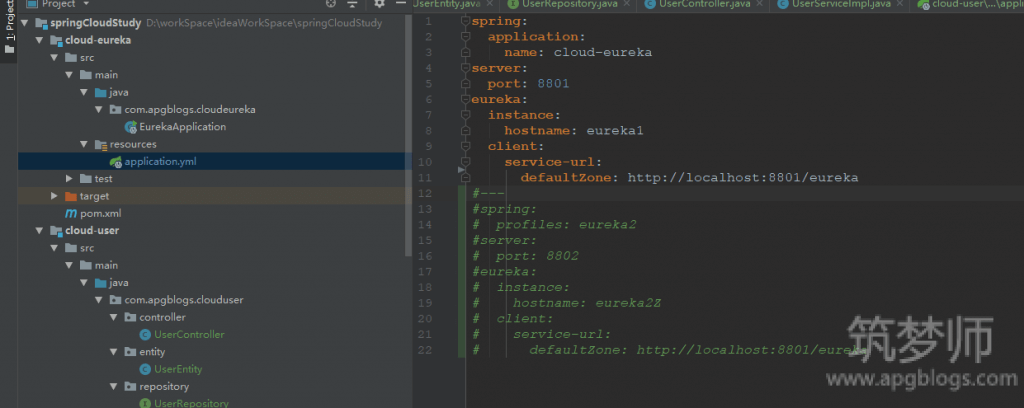
8、启动项目访问测试
将Eureka和User两个微服务同时启动,也可以先启动Eureka在启动User,都可以的。
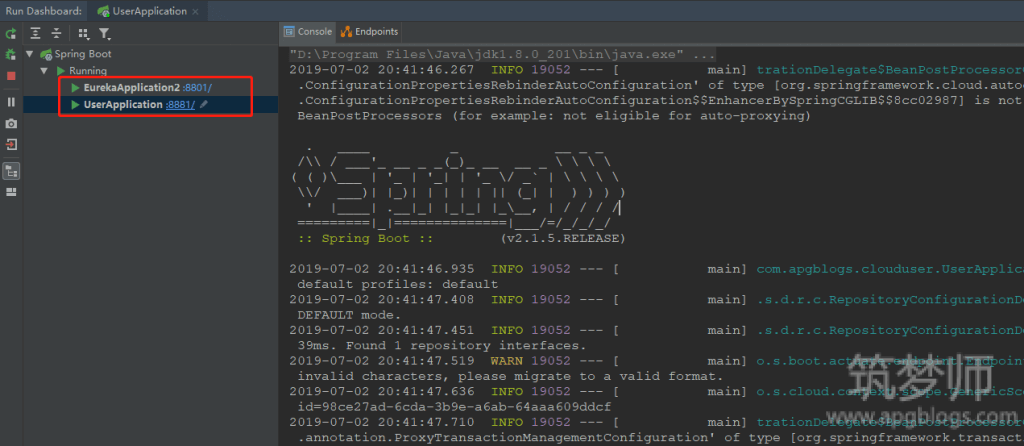
访问服务注册中心看看User微服务是不是已经出现了
如果出现以下的应用名那就用户微服务注册成功了

9、用postMan对用户微服务进行接口测试
新增用户接口测试
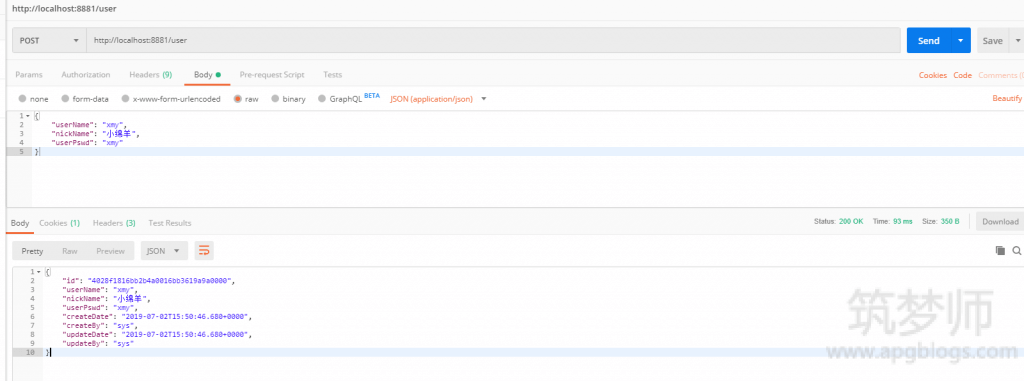
通过用户Id查询用户测试

10、文章源码地址
至此用户微服务就已经完美注册到服务中心了,也完成了用户微服务基本的新增用户和获取单个用户的restFul风格的接口,下一节会继续讲解后续的操作
你好,博主,UserController 和UserServiceImpl 代码是一样的。。。